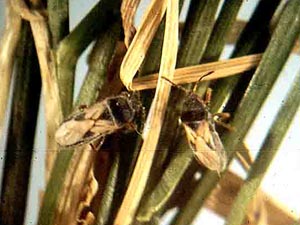Chinch Bug | |
|---|---|
| October 16, 2007 | |
|
html> We have received reports of chinch bug damage in northeastern Illinois. Several species occur in the United States, and they tend to attack grasses, which makes them serious pests in some areas on grain crops, particularly wheat. In Illinois turf, we primarily have two pest species: Hairy chinch bug, Blissus leucopterus hirtus, is a sporadic problem in the northeastern and elsewhere in northern Illinois; and chinch bug, Blissus leucopterus leucopterus, is a more common problem in the Collinsville area, as well as other areas of southern Illinois. With the dry weather now in southern Illinois, be watchful for this insect. Chinch bugs are rarely a problem in central Illinois. Chinch bugs overwinter as adults at the base of turfgrass plants and other grasses in fencerows and other protected areas. Adult chinch bugs are about 1/8 inch long, flat-topped, and black and white. Some are winged, but others are wingless or have short wings that extend about halfway down the back. They fly and crawl to turf, where they feed by sucking sap out of turfgrass crowns and stems. Eggs are laid on the turfgrass and on the ground nearby. The eggs hatch into nymphs that are red and white. When the nymphs are half-grown and about 1/16 inch long, the red turns orangish, then brownish, and then gray by the time they are fully grown and about 1/8 inch long. Nymphs feed as the adults do—by sucking sap from the crowns and stems of turfgrasses. Fully grown nymphs molt into adults, and usually another generation occurs later in the summer. Adults from the second generation seek overwintering sites during the fall. Damage appears as yellowed turf that soon turns brown, with continued feeding by the chinch bugs. Infestations are usually associated with hot, dry weather, probably because a naturally occurring fungus that is a major cause of chinch bug death is probably more widespread and common in damp weather. Damage appears to be more likely in heavily fertilized turf. High chinch bug numbers are usually found in thick, lush turf that has been heavily fertilized with nitrogen. Scout for chinch bugs by looking for the adults or nymphs at the base of turfgrass that is yellowed or brown during the growing season but is well-rooted. Because chinch bugs can be flushed out of turf, push a coffee can or similar container with both ends cut out down into the thatch. Fill the can with water. Within 5 minutes, any chinch bugs present should be floating on the surface of the water. High numbers of floating chinch bugs forming a solid ring around the inside of the can indicate that they are probably the source of the damage and that treatment is warranted. Control chinch bugs by spraying the turf with trichlorfon (Dylox) or a labeled pyrethroid, such as bifenthrin (Onyx, Talstar, Allectus), deltamethrin (DeltaGard), or lambda-cyhalothrin (Scimitar). Make sure to use enough spray to wet the crowns of the turf, where the bugs tend to live. Where chinch bugs have been a problem, avoid high fertilization programs, particularly those containing high levels of nitrogen. Endophyte-containing turfgrasses are also effective in reducing chinch bug numbers. | |
| Author: | Phil Nixon |

